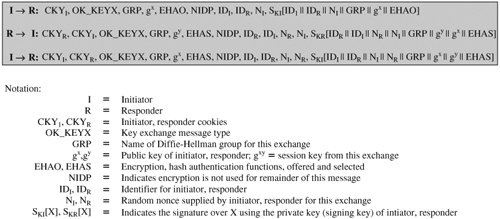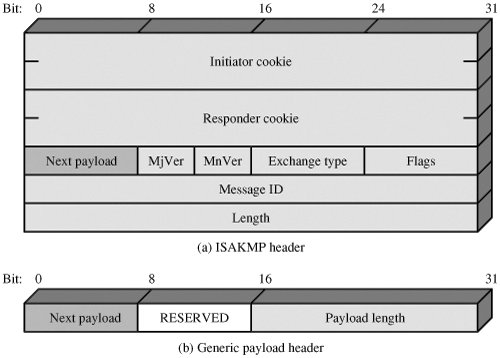Section 16.6. Key Management
16.6. Key ManagementThe key management portion of IPSec involves the determination and distribution of secret keys. A typical requirement is four keys for communication between two applications: transmit and receive pairs for both AH and ESP. The IPSec Architecture document mandates support for two types of key management:
The default automated key management protocol for IPSec is referred to as ISAKMP/Oakley and consists of the following elements:
ISAKMP by itself does not dictate a specific key exchange algorithm; rather, ISAKMP consists of a set of message types that enable the use of a variety of key exchange algorithms. Oakley is the specific key exchange algorithm mandated for use with the initial version of ISAKMP. We begin with an overview of Oakley and then look at ISAKMP. Oakley Key Determination ProtocolOakley is a refinement of the Diffie-Hellman key exchange algorithm. Recall that Diffie-Hellman involves the following interaction between users A and B. There is prior agreement on two global parameters: q, a large prime number; and a a primitive root of q. A selects a random integer XA as its private key, and transmits to B its public key YA = aXA mod q. Similarly, B selects a random integer XB as its private key and transmits to A its public key YB = aXB mod q. Each side can now compute the secret session key: The Diffie-Hellman algorithm has two attractive features:
However, there are a number of weaknesses to Diffie-Hellman, as pointed out in [HUIT98]:
Oakley is designed to retain the advantages of Diffie-Hellman while countering its weaknesses. Features of OakleyThe Oakley algorithm is characterized by five important features:
We have already discussed Diffie-Hellman. Let us look the remainder of these elements in turn. First, consider the problem of clogging attacks. In this attack, an opponent forges the source address of a legitimate user and sends a public Diffie-Hellman key to the victim. The victim then performs a modular exponentiation to compute the secret key. Repeated messages of this type can clog the victim's system with useless work. The cookie exchange requires that each side send a pseudorandom number, the cookie, in the initial message, which the other side acknowledges. This acknowledgment must be repeated in the first message of the Diffie-Hellman key exchange. If the source address was forged, the opponent gets no answer. Thus, an opponent can only force a user to generate acknowledgments and not to perform the Diffie-Hellman calculation. ISAKMP mandates that cookie generation satisfy three basic requirements:
The recommended method for creating the cookie is to perform a fast hash (e.g., MD5) over the IP Source and Destination addresses, the UDP Source and Destination ports, and a locally generated secret value. Oakley supports the use of different groups for the Diffie-Hellman key exchange. Each group includes the definition of the two global parameters and the identity of the algorithm. The current specification includes the following groups:
The first three groups are the classic Diffie-Hellman algorithm using modular exponentiation. The last two groups use the elliptic curve analog to Diffie-Hellman, which was described in Chapter 10. Oakley employs nonces to ensure against replay attacks. Each nonce is a locally generated pseudorandom number. Nonces appear in responses and are encrypted during certain portions of the exchange to secure their use. Three different authentication methods can be used with Oakley:
Oakley Exchange ExampleThe Oakley specification includes a number of examples of exchanges that are allowable under the protocol. To give a flavor of Oakley, we present one example, called aggressive key exchange in the specification, so called because only three messages are exchanged. Figure 16.11 shows the aggressive key exchange protocol. In the first step, the initiator (I) transmits a cookie, the group to be used, and I's public Diffie-Hellman key for this exchange. I also indicates the offered public-key encryption, hash, and authentication algorithms to be used in this exchange. Also included in this message are the identifiers of I and the responder (R) and I's nonce for this exchange. Finally, I appends a signature using I's private key that signs the two identifiers, the nonce, the group, the Diffie-Hellman public key, and the offered algorithms. Figure 16.11. Example of Aggressive Oakley Key Exchange When R receives the message, R verifies the signature using I's public signing key. R acknowledges the message by echoing back I's cookie, identifier, and nonce, as well as the group. R also includes in the message a cookie, R's Diffie-Hellman public key, the selected algorithms (which must be among the offered algorithms), R's identifier, and R's nonce for this exchange. Finally, R appends a signature using R's private key that signs the two identifiers, the two nonces, the group, the two Diffie-Hellman public keys, and the selected algorithms. When I receives the second message, I verifies the signature using R's public key. The nonce values in the message assure that this is not a replay of an old message. To complete the exchange, I must send a message back to R to verify that I has received R's public key. ISAKMPISAKMP defines procedures and packet formats to establish, negotiate, modify, and delete security associations. As part of SA establishment, ISAKMP defines payloads for exchanging key generation and authentication data. These payload formats provide a consistent framework independent of the specific key exchange protocol, encryption algorithm, and authentication mechanism. ISAKMP Header FormatAn ISAKMP message consists of an ISAKMP header followed by one or more payloads. All of this is carried in a transport protocol. The specification dictates that implementations must support the use of UDP for the transport protocol. Figure 16.12a shows the header format for an ISAKMP message. It consists of the following fields:
Figure 16.12. ISAKMP Formats ISAKMP Payload TypesAll ISAKMP payloads begin with the same generic payload header shown in Figure 16.12b. The Next Payload field has a value of 0 if this is the last payload in the message; otherwise its value is the type of the next payload. The Payload Length field indicates the length in octets of this payload, including the generic payload header. Table 16.3 summarizes the payload types defined for ISAKMP, and lists the fields, or parameters, that are part of each payload. The SA payload is used to begin the establishment of an SA. In this payload, the Domain of Interpretation parameter identifies the DOI under which negotiation is taking place. The IPSec DOI is one example, but ISAKMP can be used in other contexts. The Situation parameter defines the security policy for this negotiation; in essence, the levels of security required for encryption and confidentiality are specified (e.g., sensitivity level, security compartment).
The Proposal payload contains information used during SA negotiation. The payload indicates the protocol for this SA (ESP or AH) for which services and mechanisms are being negotiated. The payload also includes the sending entity's SPI and the number of transforms. Each transform is contained in a transform payload. The use of multiple transform payloads enables the initiator to offer several possibilities, of which the responder must choose one or reject the offer. The Transform payload defines a security transform to be used to secure the communications channel for the designated protocol. The Transform # parameter serves to identify this particular payload so that the responder may use it to indicate acceptance of this transform. The Transform-ID and Attributes fields identify a specific transform (e.g., 3DES for ESP, HMAC-SHA-1-96 for AH) with its associated attributes (e.g., hash length). The Key Exchange payload can be used for a variety of key exchange techniques, including Oakley, Diffie-Hellman, and the RSA-based key exchange used by PGP. The Key Exchange data field contains the data required to generate a session key and is dependent on the key exchange algorithm used. The Identification payload is used to determine the identity of communicating peers and may be used for determining authenticity of information. Typically the ID Data field will contain an IPv4 or IPv6 address. The Certificate payload transfers a public-key certificate. The Certificate Encoding field indicates the type of certificate or certificate-related information, which may include the following:
At any point in an ISAKMP exchange, the sender may include a Certificate Request payload to request the certificate of the other communicating entity. The payload may list more than one certificate type that is acceptable and more than one certificate authority that is acceptable. The Hash payload contains data generated by a hash function over some part of the message and/or ISAKMP state. This payload may be used to verify the integrity of the data in a message or to authenticate negotiating entities. The Signature payload contains data generated by a digital signature function over some part of the message and/or ISAKMP state. This payload is used to verify the integrity of the data in a message and may be used for nonrepudiation services. The Nonce payload contains random data used to guarantee liveness during an exchange and protect against replay attacks. The Notification payload contains either error or status information associated with this SA or this SA negotiation. The following ISAKMP error messages have been defined:
The only ISAKMP status message so far defined is Connected. In addition to these ISAKMP notifications, DOI-specific notifications are used. For IPSec, the following additional status messages are defined:
The Delete payload indicates one or more SAs that the sender has deleted from its database and that therefore are no longer valid. ISAKMP ExchangesISAKMP provides a framework for message exchange, with the payload types serving as the building blocks. The specification identifies five default exchange types that should be supported; these are summarized in Table 16.4. In the table, SA refers to an SA payload with associated Protocol and Transform payloads.
The Base Exchange allows key exchange and authentication material to be transmitted together. This minimizes the number of exchanges at the expense of not providing identity protection. The first two messages provide cookies and establish an SA with agreed protocol and transforms; both sides use a nonce to ensure against replay attacks. The last two messages exchange the key material and user IDs, with an authentication mechanism used to authenticate keys, identities, and the nonces from the first two messages. The Identity Protection Exchange expands the Base Exchange to protect the users' identities. The first two messages establish the SA. The next two messages perform key exchange, with nonces for replay protection. Once the session key has been computed, the two parties exchange encrypted messages that contain authentication information, such as digital signatures and optionally certificates validating the public keys. The Authentication Only Exchange is used to perform mutual authentication, without a key exchange. The first two messages establish the SA. In addition, the responder uses the second message to convey its ID and uses authentication to protect the message. The initiator sends the third message to transmit its authenticated ID. The Aggressive Exchange minimizes the number of exchanges at the expense of not providing identity protection. In the first message, the initiator proposes an SA with associated offered protocol and transform options. The initiator also begins the key exchange and provides its ID. In the second message, the responder indicates its acceptance of the SA with a particular protocol and transform, completes the key exchange, and authenticates the transmitted information. In the third message, the initiator transmits an authentication result that covers the previous information, encrypted using the shared secret session key. The Informational Exchange is used for one-way transmittal of information for SA management. | ||||||||||||||||||||||||||||||||||||||||||||||||||||||||||||||||||||||||||||||||||||||||||||||||||||||||||||||||||
EAN: 2147483647
Pages: 209

 R
R